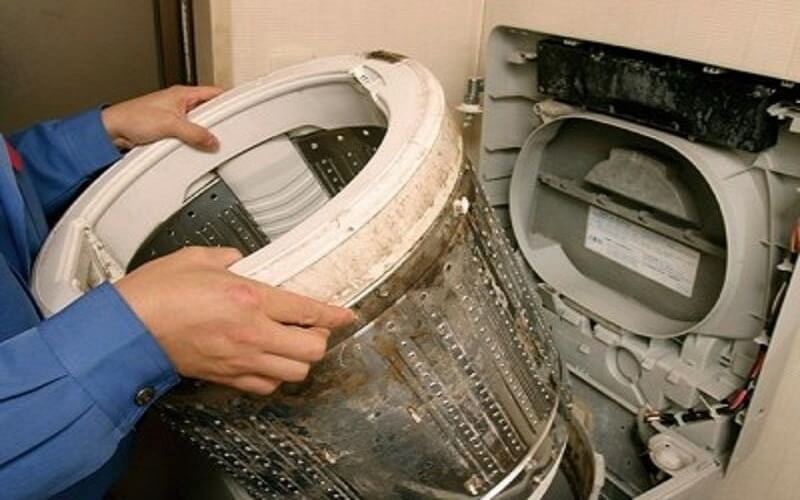Not only dust but mold is also a cause of health problems for your family. We point out 4 locations in your house that are very prone to mold growth and how to fix them in the following article.
1 Washing Machine
Washing machines are electronic devices that make laundry easier and save time for other tasks. However, once the washing process is finished and the clothes are hung to dry, this is when mold spores in the air attach themselves to the inside of the machine and its other parts.
 Mold can grow in washing machines if they don’t dry properly
Mold can grow in washing machines if they don’t dry properly
Due to the enclosed design of washing machines, they provide an ideal environment for mold to thrive, the most dangerous being the Cladosporium species which can trigger asthma attacks and lead to respiratory failure and even death.
Many households assume that since detergent is used in the washing machine, the inside must be clean. Unfortunately, it only cleans the clothes, not the interior of the machine. As a result, you may come into contact with mold without realizing it, which can have serious consequences for your health.
2 Bathroom Items and Bottles
In everyone’s bathroom, there are bound to be bottles of soap, shower gel, and other products, and among them is the potential for Cladosporium mold growth, which can trigger asthma attacks and lead to respiratory failure and even death.
 Bathroom bottles and containers are prone to mold growth
Bathroom bottles and containers are prone to mold growth
Since the bathroom is the most humid area in the house, bottles and other objects are very susceptible to mold spores in the air, regardless of whether they contain disinfectants or not. The outside of these containers may not be as clean as you think.
3 Faucets
 Faucets are susceptible to mold, especially the Trichosporon species
Faucets are susceptible to mold, especially the Trichosporon species
Faucets are particularly susceptible to mold, especially the Trichosporon species, which is a type of mold that can cause respiratory allergies. Prolonged exposure can lead to symptoms such as coughing, shortness of breath, and rhinitis, commonly seen in the summer in tropical and temperate countries.
Because faucets are constantly in use and exposed to water, they are always damp, creating an ideal environment for mold growth.
4 Curtains
In addition to collecting dust, curtains are also a breeding ground for mold. One such mold is “smoke mold” or Aspergillus fumigatus, which can cause pneumonia and lung cancer if your immune system is weak.
 Curtains can harbor mold and should be cleaned regularly
Curtains can harbor mold and should be cleaned regularly
Typically, if you’re in good health, your body can easily eliminate these mold spores. However, if there are children in the house who like to play hide-and-seek behind curtains, extra care should be taken to ensure the curtains are clean.
5 Health Hazards of Prolonged Exposure to Mold
In addition to the four locations and four types of dangerous mold mentioned above, living in a moldy environment can also lead to various health issues, as mold comes in many species and can cause different illnesses.
As mentioned earlier, mold thrives in warm, damp conditions and reproduces by doubling in size, releasing spores into the air. These spores are a major component of indoor and workplace dust and can easily be inhaled by family members.
 Mold comes in many species and can cause a variety of health issues
Mold comes in many species and can cause a variety of health issues
If you regularly inhale mold spores and have a weak immune system, you may experience various respiratory problems such as sneezing, itchy eyes, headaches, fatigue, joint pain, hives, coughing, asthma, and nausea.
 Inhaling mold spores regularly can lead to respiratory issues
Inhaling mold spores regularly can lead to respiratory issues
Moreover, common mold species can produce mycotoxins, which can have serious health implications for humans and animals. If you live in an environment infested with mold, high levels of mycotoxins can cause neurological problems and even lead to death.
This is especially true for children, the elderly, and those with weakened immune systems or pre-existing conditions such as cystic fibrosis or chronic pneumonia, as they are more susceptible to immune system infections if exposed to the dangerous mold species mentioned above.
6 How to Prevent and Control Mold Growth in Your Home
To stop mold from growing, eliminate the conditions it needs to thrive. The health risks associated with mold exposure can take time to manifest, so it’s crucial to be vigilant and take the following steps to protect yourself and your family:
Bathroom Items
Bottles and containers should be discarded immediately after use and cleaned with reputable disinfectants weekly to kill mold and harmful bacteria.
 Discard empty bottles and clean bathroom items regularly
Discard empty bottles and clean bathroom items regularly
Ensure your bathroom has a window, a dehumidifier, and an air purifier or exhaust fan to keep the air circulating and prevent a stuffy, humid environment that encourages mold growth.
Appliances like Washing Machines
 Regularly clean appliances like washing machines to prevent mold
Regularly clean appliances like washing machines to prevent mold
Schedule regular cleaning and maintenance for your appliances, ideally once a month. Most electronics brands offer warranty and cleaning services, so you can contact them to arrange a convenient time for cleaning your washing machine.
After using the washing machine, leave the door open for a few minutes to allow the interior to dry, and wipe down the machine with a dry cloth to prevent moisture buildup. Place the machine in the driest area possible.
Curtains
Wash or sun-dry your curtains to kill mold and bacteria, and open the windows to keep the air circulating and prevent a damp environment that encourages mold growth.
 Wash or sun-dry your curtains to keep them mold-free
Wash or sun-dry your curtains to keep them mold-free
Faucets should also be cleaned regularly with disinfectant solutions, and dried after use to prevent mold, rust, and discoloration.
Additionally, beyond these four locations, maintain a clean and dry home by regularly cleaning and ensuring proper ventilation.
The locations mentioned above are the most prone to mold growth, and we hope that through this article, you can identify these areas and take the necessary steps to protect your family’s health and your own.






































